![]()
![]()
![]()
Use LEFT and RIGHT arrow keys to navigate between flashcards;
Use UP and DOWN arrow keys to flip the card;
H to show hint;
A reads text to speech;
43 Cards in this Set
- Front
- Back
|
Lima beans were domesticated in...
|
the Americas.
|
|
|
Pigs were domesticated in...
|
Southwest Asia
|
|
|
Potatoes were domesticated in...
|
the Americas.
|
|
|
Seed agriculture probably reached Europe from...
|
Southwest Asia.
|
|
|
The direction and frequency of hunter-gatherer migration depended on...
|
the movement of game and the seasonal growth of plants.
|
|
|
The earliest known domesticated squash crops are thought to have originated in the Americas more than...
|
9,000 years ago.
|
|
|
The earliest known domesticated wheat, barley, and rice crops are thought to have originated in Asia about...
|
10,000 years ago.
|
|
|
The first people to domesticate lentils and olives were in...
|
Southwest Asia.
|
|
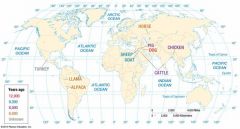
The map of animal hearths indicates that... a. pigs, goats, and sheep were domesticated in the Americas. b. chickens were domesticated in the Americas. c. llamas, alpacas, and turkeys were domesticated in the Americas. d. animals can be raised only in and near specific hearths, owing to the limited number of climates in the world. e. horses were domesticated in the Americas. |
llamas, alpacas, and turkeys were domesticated in the Americas.
|
|
|
Which is not a form of subsistence agriculture? a. All of the above are forms of subsistence agriculture. b. pastoral nomadism c. Mediterranean d. intensive e. shifting cultivation |
Mediterranean
|
|

According to the map of dietary energy by source, rice is the leading energy source in... a. Algeria, Sudan, and Ethiopia. b. Peru, India, and Ecuador. c. Peru, Brazil, and Mexico. d. Bolivia, Peru, and Brazil. e. Pakistan, Iran, and India. |
Peru, India, and Ecuador.
|
|
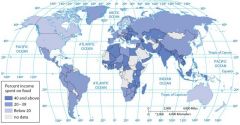
According to the map of income spent on food, more than 40 percent of average income is spent on food in... a. Syria, Malawi, Kenya, Australia, and Madagascar. b. Madagascar, Mexico, Brazil, Guatemala, Syria, and Laos. c. Syria, Iraq, Laos, Mexico, and Canada. d. Algeria, Syria, Madagascar, and Laos. e. Laos, Cuba, Brazil, and Madagascar. |
Algeria, Syria, Madagascar, and Laos.
|
|
|
After maize, the most important crop in the U.S. mixed crop and livestock region is...
|
soybeans
|
|
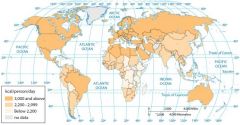
Using the map of dietary energy consumption as a reference (and momentarily ignoring other factors), we could predict that among the following countries, those most likely to suffer food shortages and/or undernourishment in the near future would be... a. Kenya, Canada, Mexico, and Brazil. b. Kenya, Ethiopia, India, and Brazil. c. Ethiopia, Somalia, South Sudan, and Yemen. d. Bolivia, Mexico, Guatemala, Peru, and Ecuador. e. Kenya, Ethiopia, Yemen, and Chad. |
Kenya, Ethiopia, Yemen, and Chad.
|
|

According to the map of world milk production, between 1 and 9 million metric tons of milk are produced annually in... a. Mexico. b. Iran. c. Bolivia. d. Libya. e. Iraq. |
Iran.
|
|
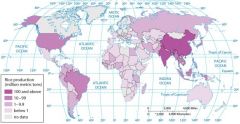
According to the map of world rice production, between 10 and 99 million metric tons of rice are produced annually in... a. Brazil, Thailand, and the United States. b. Iran, Iraq, and Afghanistan. c. Brazil, Thailand, India, Japan, and China. d. the United States, China, and India. e. China and India |
Brazil, Thailand, and the United States.
|
|
|
Compared to shifting cultivation, intensive subsistence agriculture is characterized by which of the following? a. lower population densities b. more diversified cropping c. smaller farms d. greater use of land in rainforests e. greater use of animal power |
greater use of animal power
|
|
|
Geographer Derwent Whittlesey divided the world into agricultural regions (not including his area of nonexistent agriculture), ________ of which were classified as found in MDCs and ________ as found in LDCs.
|
6; 5
|
|
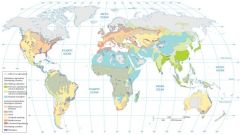
Judging from the map of agricultural regions, which type of agriculture occupies the largest percentage of Iran?
|
pastoral nomadism
|
|
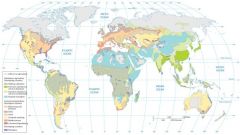
Judging from the map of agricultural regions, which type of agriculture occupies the largest percentage of southeastern China?
|
intensive subsistence
|
|
|
Pastoral nomadism is most commonly found in which climate region?
|
dry
|
|
|
Shifting cultivation is most commonly found in which climate region?
|
humid low-latitude
|
|
|
The decline in the number of farmers in MDCs can best be described as a consequence of...
|
push/pull economic factors, including the lack of opportunity in rural areas and higher-paying jobs in urban areas.
|
|
|
The different areas of the world where Mediterranean agriculture predominates have similar...
|
climate.
|
|
|
The predominant form of agriculture in the U.S. Southeast is...
|
commercial gardening.
|
|
|
The seasonal migration of livestock between mountains and lowland pastures is...
|
transhumance.
|
|
|
Truck farming is a term that derives from the Middle-English word truck, meaning...
|
"bartering" or "exchange of commodities."
|
|
|
What is the purpose of crop rotation?
|
maintaining the fertility of fields
|
|
|
Which is a characteristic of shifting cultivation? a. Swiddens not under cultivation are used for mining operations. b. A new site is designated every 50 years. c. Debris is mulched to provide the soil with nutrients. d. Land is cleared by tractors or large work crews. e. A new site is designated every few years. |
A new site is designated every few years.
|
|
|
Which of the following is the most common form of commercial agriculture in Europe? a. Mediterranean agriculture b. dairy farming c. grain farming d. livestock ranching e. mixed crop and livestock farming |
mixed crop and livestock farming
|
|
|
Which of the following is not a strategy for increasing food supply? a. identifying new food sources b. expanding arable land area c. ensuring sustainable land productivity for future generations d. increasing tariffs on grain exports e. increasing exports of surplus production |
increasing tariffs on grain exports
|
|
|
A principal practice of sustainable agriculture is...
|
careful land management
|
|
|
Afghanistan is important to the world drug trade primarily because...
|
it produces about 90 percent of the world's opium.
|
|
|
Farmers in LDCs choose to grow drug crops for export primarily because of...
|
their market value in MDCs.
|
|
|
In the winter wheat area of the U.S., the crop is planted in...
|
autumn and harvested in summer.
|
|
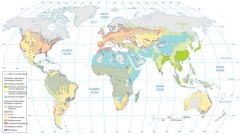
Judging from the map of agricultural regions, which type of agriculture occupies the largest percentage of Iran?
|
pastoral nomadism
|
|
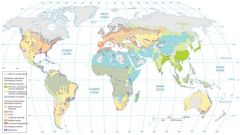
Judging from the map of agricultural regions, which type of agriculture occupies the largest percentage of southeastern China?
|
intensive subsistence
|
|
|
The best way to block Asian carp from moving into the Great Lakes from the Illinois River would be the closing of locks and dams in and near Chicago; however, these waterways are not being closed because...
|
as major transportation links for the region, they are important for Chicago's economy.
|
|
|
The United States had about 60 percent fewer farms and ________ percent fewer farmers in 2000 than in 1900.
|
85
|
|
|
To increase crop yields, farmers in South China commonly practice...
|
double cropping.
|
|
|
Von Thünen's model can best be used to explain the location of which of the following types of agriculture? a. Mediterranean agriculture in central Chile b. dairying in the Northeast United States c. shifting cultivation in the tropics of South America d. intensive subsistence in South China e. ranching in the dry lands of North Africa |
dairying in the Northeast United States
|
|
|
________ model is used by geographers to explain the importance of proximity to the market in the choice of crops to the commercial farm.
|
von Thünen's
|
|
|
True or False: The green revolution has allowed agricultural production to increase at a rate equal to population growth. |
False
|

